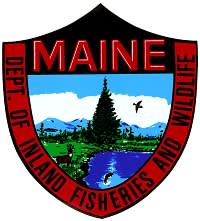Maine’s IFW Radio-Collar Moose Research Project Begins

This morning, the Maine Department of Inland Fisheries and Wildlife embarked on an intensive 5-year moose research project that will give department biologists an even greater understanding of the health of the Maine moose population, including such keys as adult and calf survival rates and reproductive rates.
“Maine’s moose population is healthy and strong,” said Lee Kantar, the department’s moose biologist. “This research project is an important tool in managing Maine’s moose population, and will benefit all who enjoy Maine’s moose.”
A trained crew that specializes in capturing and collaring large animals is utilizing a helicopter, cartridge-launched nets and immobilization darts to capture and collar female moose and calves in an area located in and around Jackman and Greenville (centered in Wildlife Management District 8).
The plan calls for the crew to capture and collar 30 adult female moose and 30 calves. This area of western Maine was chosen since it is within the core moose range of the state, and earlier research shows that this area already has a lower cow to calf ratio than other parts of the state. The geography and winter conditions of the area are also representative of much of Maine’s moose habitat.
“Capturing more information on female moose and their young is the key to improving our moose management,” said Kantar.
Aero Tech, Inc. specializes in this type of capture and collaring, and recently completed a similar job in New Hampshire. The crew, based out of New Mexico, consists of a team of four, with each having a specialized role in the process.
Kantar, with the assistance of the Maine Forest Service Air Operations Branch, has been scouting and marking GPS coordinates within WMD 8 already. This information will assist Aero Tech in finding moose in this area.
“The Maine Forest Service and their pilots have been extremely helpful in providing flights to locate moose, as well as assisting us with our moose population surveys over the last 4 winters,” said Kantar.
Once collared, the GPS-enabled collars will transmit twice a day, providing biologists the ability to track moose movements. The GPS collars are expected to transmit movement signals for four years. If there is no movement for a certain period of time, the collar transmits a mortality signal, and biologists will then travel by foot to investigate the cause of death.
“Once we receive a mortality signal, we will locate the dead moose within 24 hours,” said Kantar. Where possible, the entire body will be removed to conduct a necropsy in the lab in cooperation with the University of Maine-Animal Health Lab, but if this is not possible, a field necropsy will be conducted.
In May, as females prepare to give birth, movements will also be closely monitored. Once females give birth to calves, biologists will keep a close eye on the young calves.
“After birth, we will use walk-in surveys to monitor calving, as this will give us more information on behavior and mortality,” said Kantar.
This will be the first year of the monitoring study. Additional moose and calves will be captured and collared next year.
This survey is in addition to the research that is already being conducted on Maine’s moose. IFW utilizes aerial flights to assess population and the composition of the moose herd. During the moose hunting season, biologists also examine teeth, the number of ticks a moose carries, and in some cases, examine ovaries to determine reproductive rates.
This will be the second time that moose have been radio-collared in Maine. In the early 1980’s, moose were radio-collared tin order to better understand the range of the moose population.

